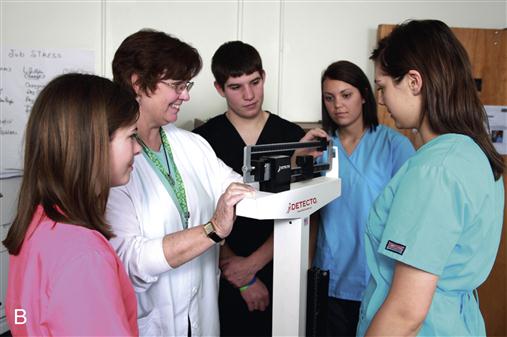The nursing assistant in long-term care
Objectives
• Define the key terms and key abbreviations listed in this chapter.
• Explain the history and current trends affecting nursing assistants.
• Explain the laws that affect nursing assistants.
• Describe the training and competency evaluation requirements for nursing assistants.
• Identify the information in the nursing assistant registry.
• Explain how to obtain certification, a license, or registration in another state.
• Describe what nursing assistants can do and their role limits.
• Explain why a job description is important.
• Describe the delegation process.
• Explain your role in the delegation process.
• Explain how to accept or refuse a delegated task.
Key terms
delegate To authorize another person to perform a nursing task in a certain situation
job description A document that describes what the center expects you to do
responsibility The duty or obligation to perform some act or function
KEY ABBREVIATIONS
| CNA | Certified nursing assistant, certified nurse aide |
| LNA | Licensed nursing assistant |
| LPN | Licensed practical nurse |
| LVN | Licensed vocational nurse |
| NATCEP | Nursing assistant training and competency evaluation program |
| NCSBN | National Council of State Boards of Nursing |
| OBRA | Omnibus Budget Reconciliation Act of 1987 |
| RN | Registered nurse |
| RNA | Registered nurse aide |
Federal and state laws and nursing center policies combine to define the roles and functions of each health team member. Everyone must protect residents from harm. To do so, you need to know:
Laws, job descriptions, and the person’s condition shape your work. So does the amount of supervision you need.
History and current trends
For decades, nursing assistants have helped nurses with basic nursing care. Often called nurse’s aides, they gave baths and made beds. They helped with grooming, elimination, and other needs. Their work was similar in hospitals and nursing centers. Until the 1980s, training was not required by law. Nurses gave on-the-job training. Some hospitals, nursing centers, and schools offered nursing assistant courses.
Before the 1980s, team nursing was common. A registered nurse (RN) was the team leader. The RN assigned care to nurses and nursing assistants. Care was assigned according to each person’s needs and condition. It also depended on the staff member’s education and experiences.
Primary nursing was common in the 1980s. RNs planned and gave care. Many hospitals only hired RNs. Meanwhile, nursing centers relied on nursing assistants for resident care.
Home care increased during the 1980s. Prospective payment systems limit health care payments (Chapter 1). To reduce care costs, hospital stays also are limited. Therefore patients are discharged earlier than in the past. Often they are still quite ill and need home care.
Efforts to reduce health care costs include:
Federal and state laws
The U.S. Congress makes federal laws that all 50 states must follow. State legislatures make state laws. For example, the New York legislature makes state laws for New York. The Texas legislature makes state laws for Texas. You must know the federal and state laws that affect your work. They provide direction for what you can do.
See Chapter 4 for other laws affecting your work.
Nurse practice acts
Each state has a nurse practice act. It protects the public’s welfare and safety by regulating nursing practice in that state. A nurse practice act:
• Describes the scope of practice for RNs and LPNs/LVNs.
The law allows for denying, revoking, or suspending a nursing license. The purpose is to protect the public from unsafe nurses. Reasons include:
• Being convicted of a crime in any state
• Selling or distributing drugs
• Using the person’s drugs for oneself
• Placing a person in danger from the over-use of alcohol or drugs
• Demonstrating grossly negligent nursing practice
• Being convicted of abusing or neglecting children or older persons
• Violating a nurse practice act and its rules and regulations
• Demonstrating incompetent behaviors
• Aiding or assisting another person to violate a nurse practice act and its rules and regulations
Nursing assistants
A state’s nurse practice act is used to decide what nursing assistants can do. Some nurse practice acts also regulate nursing assistant roles, functions, education, and certification requirements. Other states have separate laws for nursing assistants.
Legal and advisory opinions about nursing assistants are based on the state’s nurse practice act. So are any state laws about their roles and functions. If you do something beyond the legal limits of your role, you could be practicing nursing without a license. This creates serious legal problems for you and the nurse supervising your work.
Nursing assistants must be able to function with skill and safety. Like nurses, nursing assistants can have their certification (p. 22) denied, revoked, or suspended. The National Council of State Boards of Nursing (NCSBN) lists these reasons for doing so:
• Substance abuse or dependency.
• Abandoning, abusing, or neglecting a resident.
• Fraud or deceit. Examples include:
• Filing false personal information
• Providing false information when applying for initial certification or to have it re-instated
• Violating professional boundaries (Chapter 4).
• Performing acts beyond the nursing assistant role.
• Misappropriation (stealing, theft) or mis-using property.
• Having been convicted of a crime. Examples include murder, assault, kidnapping, rape or sexual assault, robbery, sexual crimes involving children, criminal mistreatment of children or a vulnerable adult (Chapter 4), drug trafficking, embezzlement (to take a person’s property for one’s own use), theft, and arson (starting fires).
• Failing to conform to the standards of nursing assistants (p. 25).
• Putting residents at risk for harm.
• Violating a resident’s privacy.
• Failing to maintain the confidentiality of resident information.
 The omnibus budget reconciliation act of 1987
The omnibus budget reconciliation act of 1987
The Omnibus Budget Reconciliation Act of 1987 (OBRA) is a federal law. Its purpose is to improve the quality of life of nursing center residents.
OBRA sets minimum training and competency evaluation requirements for nursing assistants. Each state must have a nursing assistant training and competency evaluation program (NATCEP). A nursing assistant must successfully complete a NATCEP to work in a nursing center, hospital long-term care unit, or home care agency receiving Medicare funds.
The training program
OBRA requires at least 75 hours of instruction. Some states have more hours. At least 16 hours of supervised practical training are required. Such training occurs in a laboratory or clinical setting (Fig. 3-1, p. 22). Students perform nursing care and tasks on another person. A nurse supervises this practical training (clinical practicum or clinical experience).
The training program includes the knowledge and skills needed to give basic nursing care. Areas of study include:
Competency evaluation
The competency evaluation has a written test and a skills test (Appendix A, p. 722). The written test has multiple-choice questions. Each has 4 choices. Only 1 answer is correct. The number of questions varies from state to state.
The skills test involves performing nursing skills. You will perform certain skills learned in your training program.
You take the competency evaluation after your training program. Your instructor tells you when and where the tests are given. He or she helps you complete the application. There is a fee for the evaluation. If working in a nursing center, the employer pays this fee. You are told the place and time of the tests after your application is processed. Some states give a choice of test dates and sites.
Your training prepares you for the competency evaluation. If you listen, study hard, and practice safe care, you should do well. If the first attempt was not successful, you can retest. OBRA allows at least 3 attempts to successfully complete the evaluation.
Nursing assistant registry
OBRA requires a nursing assistant registry in each state. It is an official record or listing of persons who have successfully completed that state’s approved NATCEP. The registry has information about each nursing assistant:
• Full name, including maiden name and any married names.
• Registry number and the date it expires.
• Last known employer, date hired, and date employment ended.
• Date the competency evaluation was passed.
Any agency (hospital, nursing center, home care agency) can access registry information. You also receive a copy of your registry information. The copy is provided when the first entry is made and when information is changed or added. You can correct wrong information.
Other OBRA requirements
Retraining and a new competency evaluation program are required for nursing assistants who have not worked for 24 months. It does not matter how long you worked as a nursing assistant. What matters is how long you did not work. States can require:
Nursing centers must provide 12 hours of educational programs to nursing assistants every year. Performance reviews also are required. That is, your work is evaluated. These requirements help ensure that you have the current knowledge and skills to give safe, effective care.
See Teamwork and Time Management: Other OBRA Requirements.
Certification
Each state’s NATCEP must meet OBRA requirements. Some states require more training hours. And each state has its own competency evaluation program. After successfully completing your state’s NATCEP, you have the title used in your state:
• Certified nursing assistant (CNA) or certified nurse aide (CNA). CNA is used in most states.
• Licensed nursing assistant (LNA).
• Registered nurse aide (RNA).
Working in another state
To work in another state, you must meet that state’s registry requirements. First, contact the state agency responsible for NATCEPs and the nursing assistant registry. To find that agency, do one of the following:
• Contact your current nursing assistant registry.
• Go to the National Council of State Boards of Nursing website. Find the link to the state agency.
Then apply to the state agency to be a CNA (LNA, RNA). The state uses one of these terms: endorsement, reciprocity, or equivalency. The terms mean that:
• Your application for CNA (LNA, RNA) is reviewed to see if you meet the state’s requirements:
• Your certification (license, registration) is current and in good standing
• You meet that state’s education, work, and legal requirements
• Certification (a license, registration) is granted if the requirements are met.
Stay updated, free articles. Join our Telegram channel

Full access? Get Clinical Tree




